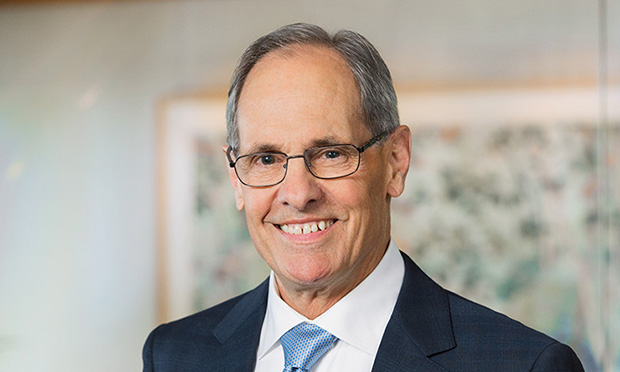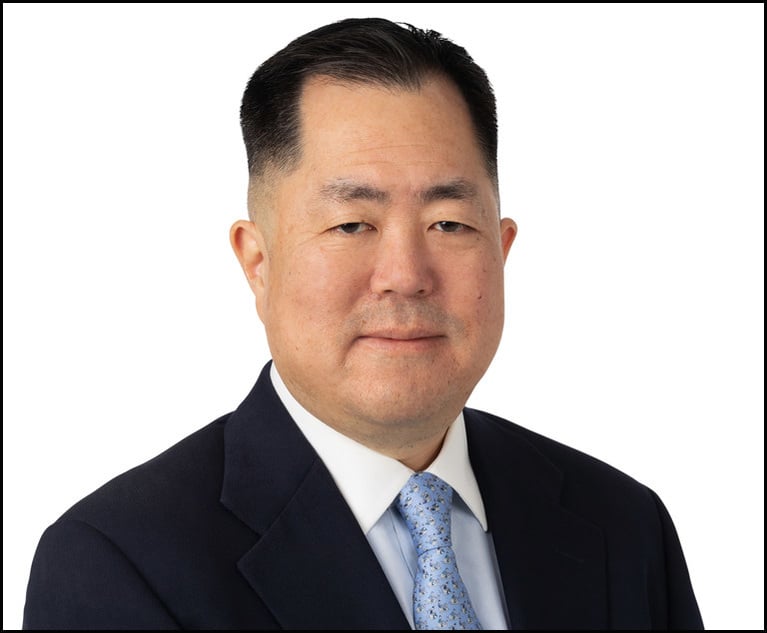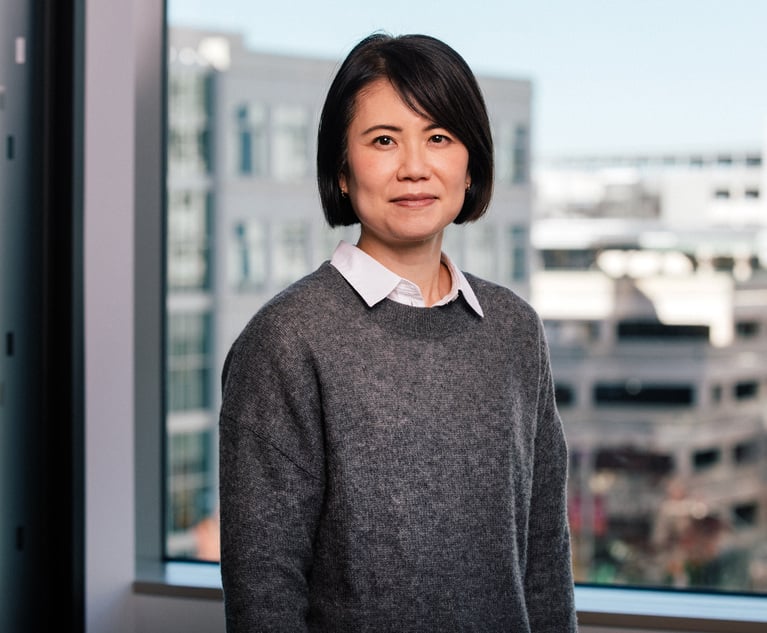Shartsis Friese Leans on Transparency and Core Strengths to Navigate Tough Times
"We are committed to doing everything we can to retain our people," says firm founder and managing partner Art Shartsis. "We will get through this together as a firm and come out the other side stronger for it."
April 08, 2020 at 03:03 PM
8 minute read
 Art Shartsis, Shartsis Friese. (Courtesy photo)
Art Shartsis, Shartsis Friese. (Courtesy photo)
In lieu of any formal celebration, Shartsis Friese has so far marked its 45th anniversary as a firm by growing. The 65-lawyer San Francisco boutique has added 11 new partners in the past 12 months, including laterals and internal promotions. Founding partner Art Shartsis recently participated in a Q&A series with The Recorder affiliate The Mid-Market Report aimed at helping readers get to know midsize law firms around the country, and how they are innovating in an ever-changing legal landscape. More information about subscribing to the Mid-Market Report is available here.
Firm Name: Shartsis Friese
Firm Leader: Art Shartsis, founder and managing partner
Firm Head Count: 65
Location: San Francisco
Practice Areas: Investment Funds and Advisers, Real Estate, Litigation, Intellectual Property, Corporate, Tax, Family Wealth Planning, Venture Capital, Securities Enforcement Defense
Governance structure and compensation model: Shartsis Friese has a managing partner and a management committee that includes an associate member with full voting rights. The firm is remarkable for its completely objective and transparent compensation model. Partners are paid based on hours billed and collected, business brought to the firm, and hours spent on firm-required administrative matters. No subjective decisions are made about what a partner should earn. The partners know each other's compensation. The system is universally viewed as fair and contributes to the remarkable stability of the firm.
**The following answers were provided by Shartsis and edited lightly for style.**
Do you offer alternative fee arrangements?
Because we offer the same quality services as the large national firms which with we compete at lower and reasonable rates, we primarily bill based on hours worked. In special situations, we develop alternative fee arrangements where it makes sense for all parties.
What do you view as the two biggest opportunities for your firm, and what are the two biggest threats?
The two biggest threats to every firm at this time are COVID-19—the pandemic itself and the economic consequences that accompany it. We are, however, confident that we will be able to ride out the storm given the diversification of our practice that we have carried out over the last 10 years. We have a handful of elite practices that while complementing each other, also exist somewhat independently. Our hedge fund practice is busy right now and likely to stay that way. Our family wealth management group will stay busy, because the nature of the pandemic has caused people to focus on their estate plans. Our real estate practice is dealing with a whole variety of impacts on leasing, development and financing. Corporate transactional work is focusing on deals and relationships that are imperiled by the huge impact on the economy.
Our litigation group is perfectly positioned to address the myriad of commercial disputes that are coming. Even though we have been through a number of national economic downturns over the years, our firm has never laid off a lawyer or staff member for economic reasons. We are committed to doing everything we can to retain our people. We will get through this together as a firm and come out the other side stronger for it.
In terms of opportunities, I think that our firm and model will be attractive to lateral partners in the current environment. It has already been very attractive to lawyers from large firms who have joined us and thrived. We have a strong, stable platform with practice leaders who are among the best in their fields in California and in some cases nationwide. We have always been very careful about growth and place a high premium on stability. We don't carry debt. We have very low turnover. We are like a sports team, always looking to fill roster spots and expect there to be some very talented people in the market in these difficult times looking for a stable, supportive firm where they can build their practice.
The legal market is so competitive now—what trends do you see, and has anything, including alternative service providers, altered your approach? Is your chief competition other midmarket firms, or is your firm competing against big firms for the same work?
I don't think our approach has changed all that much. Clients come to us and stay because of the reputation and strength of our lawyers. We're competing against both big firms and smaller firms, depending on the practice area. As one of the go-to firms in the country in hedge funds, for example, we're competing with the leading players in New York. We have an incredibly strong real estate practice that represents a roster of name-brand tech companies in San Francisco and Silicon Valley in some of their biggest deals, and also represents entrepreneurs. Our family wealth estate planning group—which we recently expanded—represents prominent families in California and nationally, and has the capability of advising on any size estate. Our litigation practice has thrived on big difficult cases, but also has the experience to litigate smaller matters efficiently and effectively.
There is much debate around how law firms can foster the next generation of legal talent. What advantages and disadvantages do midsize firms have in attracting and retaining young lawyers, particularly millennials?
We are a friendly, cohesive, top-level firm that encourages and supports our associates and young partners in their practice development efforts. And because we have some of the leading practitioners in their respective fields and a strong reputation in those areas and extraordinary clients, we offer a lot of opportunities to younger lawyers to work directly with clients and to bring in their own work.
Does your firm employ any nonlawyer professionals in high-level positions (e.g., COO, business development officer, chief strategy officer, etc.)? If so, why is it advantageous to have a nonlawyer in that role? If not, have you considered hiring any?
We have an excellent, highly experienced COO who we hired several years ago after a nationwide search. He replaced our prior COO who had been in that role for more than 20 years. Having a professional manager has allowed the partners to pay attention to the bigger issues and continue to practice law full time. Our COO is a fully integrated member of the management team and makes a tremendous contribution to our firm.
What would you say is the most innovative thing your firm has done recently, whether it be technology advancements, internal operations, how you work with clients, etc.?
Ironically, I think our most innovative thing may be simply staying the course—choosing to practice law in a particular way 45 years ago and sticking to it. While we maintain modern systems, we do not see our business as being on the cutting edge of operational technology.
We see ourselves first and foremost as lawyers and business strategists working closely with clients to help them grow their businesses, fend off threats and meet their goals. We have maintained our practice and tradition of hiring the best people—we are incredibly picky about who we bring into the firm—placing a premium on smart, savvy, independent, hard-working lawyers who are team players and leave their egos at the door. We like each other, and it shows in the way we practice and have been able to retain lawyers, staff, and clients.
Does your firm have a succession plan in place? If so, what challenges do you face in trying to execute that plan? If you don't currently have a plan, is it an issue your firm is thinking about?
Although I'm still managing partner after 45 years, we have already implemented a diversification and succession plan in the sense that business generation in the firm is spread out throughout the partnership, and no longer depends on me and a few other senior lawyers.
As a result, the future is as secure as it can be in these crazy times. We also have an open management and compensation structure, so all the partners know what's going on in the firm and have always been involved in important firm decisions. Major decisions are made only after active consultation and involvement of interested parties. Obviously the firm will need to choose a new leader at some point, but the foundation has already been laid. I expect it will be a smooth transition.
Read more:
California Appellate Law Group Brings Work-Life Balance to a Niche Practice
Orange County Stalwart Rutan & Tucker Expands with an Eye on the Future
This content has been archived. It is available through our partners, LexisNexis® and Bloomberg Law.
To view this content, please continue to their sites.
Not a Lexis Subscriber?
Subscribe Now
Not a Bloomberg Law Subscriber?
Subscribe Now
NOT FOR REPRINT
© 2025 ALM Global, LLC, All Rights Reserved. Request academic re-use from www.copyright.com. All other uses, submit a request to [email protected]. For more information visit Asset & Logo Licensing.
You Might Like
View All
Law Firms Close Southern California Offices Amid Devastating Wildfires

Husch Blackwell Hires Former Adobe Counsel to Oversee AI Advisory Offering
3 minute read
Legal Tech's Predictions for Artificial Intelligence in 2025
Law Firms Mentioned
Trending Stories
- 1Many LA County Law Firms Remain Open, Mobilize to Support Affected Employees Amid Historic Firestorm
- 2Stevens & Lee Names New Delaware Shareholder
- 3U.S. Supreme Court Denies Trump Effort to Halt Sentencing
- 4From CLO to President: Kevin Boon Takes the Helm at Mysten Labs
- 5How Law Schools Fared on California's July 2024 Bar Exam
Who Got The Work
Michael G. Bongiorno, Andrew Scott Dulberg and Elizabeth E. Driscoll from Wilmer Cutler Pickering Hale and Dorr have stepped in to represent Symbotic Inc., an A.I.-enabled technology platform that focuses on increasing supply chain efficiency, and other defendants in a pending shareholder derivative lawsuit. The case, filed Oct. 2 in Massachusetts District Court by the Brown Law Firm on behalf of Stephen Austen, accuses certain officers and directors of misleading investors in regard to Symbotic's potential for margin growth by failing to disclose that the company was not equipped to timely deploy its systems or manage expenses through project delays. The case, assigned to U.S. District Judge Nathaniel M. Gorton, is 1:24-cv-12522, Austen v. Cohen et al.
Who Got The Work
Edmund Polubinski and Marie Killmond of Davis Polk & Wardwell have entered appearances for data platform software development company MongoDB and other defendants in a pending shareholder derivative lawsuit. The action, filed Oct. 7 in New York Southern District Court by the Brown Law Firm, accuses the company's directors and/or officers of falsely expressing confidence in the company’s restructuring of its sales incentive plan and downplaying the severity of decreases in its upfront commitments. The case is 1:24-cv-07594, Roy v. Ittycheria et al.
Who Got The Work
Amy O. Bruchs and Kurt F. Ellison of Michael Best & Friedrich have entered appearances for Epic Systems Corp. in a pending employment discrimination lawsuit. The suit was filed Sept. 7 in Wisconsin Western District Court by Levine Eisberner LLC and Siri & Glimstad on behalf of a project manager who claims that he was wrongfully terminated after applying for a religious exemption to the defendant's COVID-19 vaccine mandate. The case, assigned to U.S. Magistrate Judge Anita Marie Boor, is 3:24-cv-00630, Secker, Nathan v. Epic Systems Corporation.
Who Got The Work
David X. Sullivan, Thomas J. Finn and Gregory A. Hall from McCarter & English have entered appearances for Sunrun Installation Services in a pending civil rights lawsuit. The complaint was filed Sept. 4 in Connecticut District Court by attorney Robert M. Berke on behalf of former employee George Edward Steins, who was arrested and charged with employing an unregistered home improvement salesperson. The complaint alleges that had Sunrun informed the Connecticut Department of Consumer Protection that the plaintiff's employment had ended in 2017 and that he no longer held Sunrun's home improvement contractor license, he would not have been hit with charges, which were dismissed in May 2024. The case, assigned to U.S. District Judge Jeffrey A. Meyer, is 3:24-cv-01423, Steins v. Sunrun, Inc. et al.
Who Got The Work
Greenberg Traurig shareholder Joshua L. Raskin has entered an appearance for boohoo.com UK Ltd. in a pending patent infringement lawsuit. The suit, filed Sept. 3 in Texas Eastern District Court by Rozier Hardt McDonough on behalf of Alto Dynamics, asserts five patents related to an online shopping platform. The case, assigned to U.S. District Judge Rodney Gilstrap, is 2:24-cv-00719, Alto Dynamics, LLC v. boohoo.com UK Limited.
Featured Firms
Law Offices of Gary Martin Hays & Associates, P.C.
(470) 294-1674
Law Offices of Mark E. Salomone
(857) 444-6468
Smith & Hassler
(713) 739-1250







